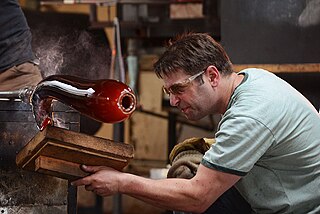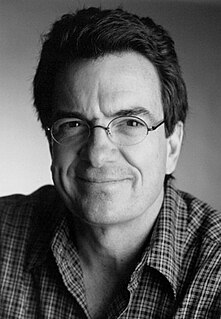
Dale Chihuly is an American glass artist and entrepreneur. He is perhaps best known in the field of blown glass, "moving it into the realm of large-scale sculpture".

Émile Gallé was a French artist and designer who worked in glass, and is considered to be one of the major innovators in the French Art Nouveau movement. He was noted for his designs of Art Nouveau glass art and Art Nouveau furniture, and was a founder of the École de Nancy or Nancy School, a movement of design in the city of Nancy, France.

Studio glass is the modern use of glass as an artistic medium to produce sculptures or three-dimensional artworks. The glass objects created are intended to make a sculptural or decorative statement. Though usage varies, the term is properly restricted to glass made as art in small workshops, typically with the personal involvement of the artist who designed the piece. This is in contrast to art glass, made by craftsmen in factories, and glass art, covering the whole range of glass with artistic interest made throughout history. Both art glass and studio glass originate in the 19th century, and the terms compare with studio pottery and art pottery, but in glass the term "studio glass" is mostly used for work made in the period beginning in the 1960s with a major revival in interest in artistic glassmaking.

American craft is craft work produced by independent studio artists working with traditional craft materials and processes. Examples include wood, glass, clay (ceramics), textiles, and metal (metalworking). Studio craft works tend to either serve or allude to a functional or utilitarian purpose, although they are just as often handled and exhibited in ways similar to visual art objects.
Marvin Bentley Lipofsky was an American glass artist. He was one of the six students that Studio Glass founder Harvey Littleton instructed in a program at the University of Wisconsin-Madison in fall 1962 and spring 1963. He was a central figure in the dissemination of the American Studio Glass Movement, introducing it to California through his tenure as an instructor at the University of California, Berkeley and the California College of Arts and Crafts.

Christopher Whitworth Whall was a British stained-glass artist who worked from the 1880s and on into the 20th century. He is widely recognised as a leader in the Arts and Crafts Movement and a key figure in the modern history of stained glass.

The Modern Style is a style of architecture, art, and design that first emerged in the United Kingdom in the mid-1880s. It is the first Art Nouveau style worldwide, and it represents the evolution of Arts and Crafts movement which was native to Great Britain. Britain not only provided the base and intellectual background for the Art Nouveau movement which was adapted by other countries to give birth to local variants; they also played an over-sized role in its dissemination and cultivation through the Liberty department store and The Studio magazine. The most important person in the field of design in general and architecture, in particular, was Charles Rennie Mackintosh. He created one of the iconic symbols of the movement, known as the Mackintosh rose or Glasgow rose. The Glasgow school was also of tremendous importance, particularly due to a group closely associated with Mackintosh, known as The Four. The Liberty store nurturing of style gave birth to two metalware lines, Cymric and Tudric.

Richard "Dick" Marquis is an American studio glass artist. One of the first Americans ever to work in a Venetian glass factory, he became a master of Venetian cane and murrine techniques. He is considered a pioneer of American contemporary glass art, and is noted for his quirky, playful work that incorporates flawless technique and underlying seriousness about form and color.

David Scott Patchen is an American glass artist who uses the techniques of cane and murrine in an American style. Patchen's work is known primarily for a combination of complexity and scale in densely patterned glass. His work is in many private and public collections internationally, featured in many publications and frequently in juried shows such as SOFA, Chicago, ART Shanghai and ART Palm Beach. His work is shown in galleries in the U.S., Canada and Europe. Patchen was awarded an artist residency in 2010 in Seto city, Japan where his visit was covered by the local media and included lectures, demonstrations and a show of his work at the Seto City Art Museum. His work has won awards and is in both private and public collections internationally. Based on Patchen's expertise, his book is part of the permanent collection of Giorgio Cini Foundation's Centro Studi del Vetro library in Venice, Italy and the Rakow Library at the Corning Museum of Glass.

Dan Owen Dailey is an American artist and educator, known for his sculpture. With the support of a team of artists and crafts people, he creates sculptures and functional objects in glass and metal. He has taught at many glass programs and is professor emeritus at the Massachusetts College of Art, where he founded the glass program.

Erwin Eisch is a German artist who works with glass. He is also a painter, draughtsman, and printmaker. With that of his friend and colleague in glass Harvey Littleton, Eisch's work in glass embodies the ideas of the international Studio Glass movement. Along with glass artists Sam Herman and Sybren Valkema, Eisch is considered a founder of studio glass in Europe.

John Littleton and Kate Vogel are American studio glass artists who have worked collaboratively since 1979. They are considered to be among the third generation of American Studio Glass Movement artists who trace their roots to the work of Harvey Littleton in the 1960s. John Littleton, the youngest child of Harvey Littleton, grew up in the shadow of his father's accomplishments in Madison, Wisconsin, where he experienced first-hand the personalities and events of the early glass movement. Glass, however, was not John Littleton's first medium of choice when it came time for him to select a career. It was only after majoring in photography at the University of Wisconsin–Madison that he began to create in glass. He soon formed a collaborative partnership with another art student, Kate Vogel, who had exchanged her study of two dimensional art for glass. The artists' earliest collaborations in glass were the bag forms for which they are well known today. Since 2000 their work has included a series of arms and hands cast in amber-colored glass. Over the years the hands have held various objects, including river stones, large faceted glass "jewels", and colorful cast glass leaves. In recent years Littleton and Vogel have also become known for their series of functional glass and wrought iron side tables.

Glass art refers to individual works of art that are substantially or wholly made of glass. It ranges in size from monumental works and installation pieces to wall hangings and windows, to works of art made in studios and factories, including glass jewelry and tableware.
Bill Boysen (1936-2020) was an American artist, specializing in the use of glass to produce three-dimensional artworks.

The V&A Rotunda Chandelier is a glass sculpture by Dale Chihuly. It hangs under the glass rotunda at the entrance to the Victoria and Albert Museum in South Kensington, London. Considered to be an artwork as much as a source of light, it was installed in 1999 and then substantially altered and enlarged to its current size in 2001, coinciding with a V&A exhibition of the artist's work.
Katherine Gray is a Canadian glass artist and professor of art at California State University, San Bernardino. Her work includes vases, candelabras, and goblets, and some of her pieces are designed to fit inside each other.
Per Bertil Sundberg is a Swedish ceramic and glass artist. Until 2005 he worked at Orrefors glassworks, and has subsequently been a professor at Konstfack and an independent artist.
David Wiseman is an American artist and designer whose work is notable for its intricate craftsmanship and dialogue with traditional decorative arts. "Celebrated for groundbreaking sculpture, furniture, lighting and site-specific installations that combine natural forms with classical craftsmanship, David Wiseman is a creative tour de force." His work spans from bronze filagree patterned screens and gates to bronze and terrazzo furniture, from animal sculptures to porcelain vases.
James Mongrain is a Seattle-area glass artist. He was educated at Moorhead State University in Minnesota, then studied glassblowing at Massachusetts College of Art and Design and the Appalachian Center for Crafts. Mongrain lives in Everett, Washington and operates a studio in Mukilteo at a former salmon smokehouse. He is considered one of the leading artists of the studio glass movement in the Pacific Northwest, and has unique mastery of Venetian goblets, combining the techniques of using a mold and blown glass on the same piece.

Michael Janis is an American artist currently residing in Washington, DC where he is one of the directors of the Washington Glass School. He is known for his work on glass using the exceptionally difficult sgraffito technique on glass.












